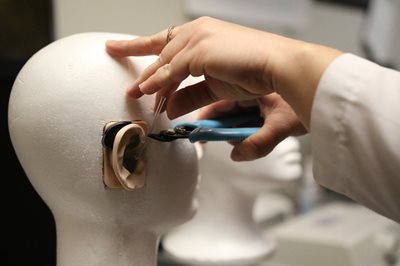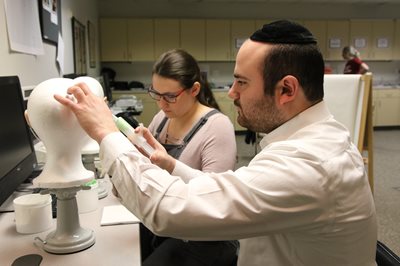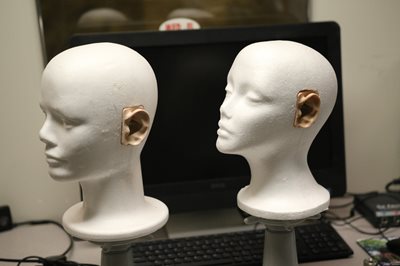Here’s a head’s up for prospective audiology students: You could be working with Styrofoam and a peanut-butter-based goop as part of your training.
No, for real. First-year, second-semester students in Dr. Rebecca Blaha’s class have been able to get a head start on their labs by being exposed to some new techniques of simulating patient care. They include using silicone ears embedded in Styrofoam heads to practice making ear mold impressions and utilizing a non-edible peanut-butter-based fake ear wax to practice cerumen removal.
 Dr. Blaha is always interested in using interesting new teaching approaches, so she borrowed the Styrofoam heads idea from a colleague to try them out this semester when teaching her students’ in labs.
Dr. Blaha is always interested in using interesting new teaching approaches, so she borrowed the Styrofoam heads idea from a colleague to try them out this semester when teaching her students’ in labs.
“We had invited Dr. David Brown from Pacific University here last year because we were reaching out to other professionals for outside opinions and new ideas,” said Dr. Blaha, assistant professor in the University’s Osborne College of Audiology (OCA) and lead audiologist at Salus University’s Pennsylvania Ear Institute (PEI). “He came to campus and talked about the simulations that are used at Pacific University and we got these ideas from him.”
Practicing ear mold impressions is important for audiology students because it’s an invasive procedure for patients. It involves placing a cotton or foam block down the ear canal fairly close to the eardrum, which can be disorienting for some patients.
“Then we use a silicone hand-mixed material that creates a mold. It’s a very odd feeling when we inject that. It’s like caulking your bathroom. We’re using silicone putty to create a hearing aid that is an exact anatomical match or an ear mold that would attach to a behind-the-ear hearing aid,” said Dr. Blaha. “The students have to practice that because they’re tested on it at the end of the semester before they’re expected to do it with patients.”
The Styrofoam heads – just like the ones that hold wigs – were purchased on Amazon. Jonette B. Owen, AuD, assistant dean of Practice and Assessment of Audiologic Medicine in the OCA, took the Styrofoam heads home and measured them in order to fit the silicone ears in place.
 “She looked at the angles to make sure they were anatomically correct. She did a lot of preparation to make them work for this semester,” said Dr. Blaha.
“She looked at the angles to make sure they were anatomically correct. She did a lot of preparation to make them work for this semester,” said Dr. Blaha.
In past labs, students usually practice making ear molds on each other, but according to Dr. Blaha, that can be a little nerve-wracking as students learn proper procedure through trial and error. So cooler heads must prevail.
“This semester I felt that they had a better experience because they were able to practice without having to touch a live patient,” she said. “We started with the Styrofoam heads and the students practiced with mixing the materials and getting a feel of how it injects. It helped get the students familiar before they had to do the real thing. I think it made their actual attempts on each other that much more successful.”
The added benefit is that students can practice as much as they want on the Styrofoam heads.
“Having the heads there and accessible at any time – outside of class – they can do as many impressions as they need before they have to show us in clinic the following semester,” said Dr. Blaha.
Dr. Blaha plans to adapt the Styrofoam heads for other procedures as well, such as cerumen removal. Pacific University’s Dr. Brown was once again the go-to guy for this as he left samples of fake ear wax with Dr. Blaha.
 “It’s peanut-butter-based, but it’s not edible. He has it in different consistencies, so students can practice each of the different removal techniques. We’re also going to be using these heads for student practice before they perform that as well on patients,” she said.
“It’s peanut-butter-based, but it’s not edible. He has it in different consistencies, so students can practice each of the different removal techniques. We’re also going to be using these heads for student practice before they perform that as well on patients,” she said.
At this point, there’s no telling how long the Styrofoam heads will last in the lab. So far, so good though, through one semester of use. The silicon ears can tear and they’re prone to pitting. But the way they’re cut into the Styrofoam, the ears can be removed, washed and reused as many times as needed.
Students haven’t yet taken to naming the Styrofoam heads, according to Dr. Blaha, but there are both male-and female-designed heads for practice and she’s excited about they have been used so far.
“I don’t know about the students, but I’ve been happy with these,” said Dr. Blaha.